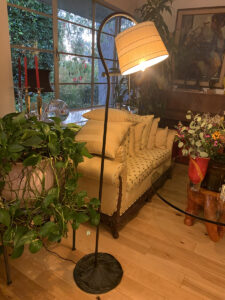 JJ owns a wonderful goose-neck floor lamp, found at the Earl Warren flea market. The base is a naturalistic bronze with a round figure of a lily pad, models of little crawfish and minnows. A stamp reads R B and Co, with what appears like two sets of numbers, likely indicating model.
JJ owns a wonderful goose-neck floor lamp, found at the Earl Warren flea market. The base is a naturalistic bronze with a round figure of a lily pad, models of little crawfish and minnows. A stamp reads R B and Co, with what appears like two sets of numbers, likely indicating model.
Is this lily pad design a favorite of Louis Comfort Tiffany by Tiffany and Company, the premier designer of Art Nouveau lighting? If made by Tiffany, it falls in the five figures, and JJ scored. However, I didn’t find similar bases by Tiffany. Tiffany usually signed their lamps with a stamp. These naturalistic elements of the fish and crawdad seem too cute. Meaning this lamp falls in a less “aesthetic” market than Tiffany buyers of 1900. Tiffany lamps are works of fine art sculpture, with restraint and dignity to their designs.
Who was R B and Co.?
Rose Brothers Company of Lancaster, Pennsylvania manufactured collapsible umbrellas. For a short time, they led the world in umbrellas. Lancaster began in 1730 as a Colonial town, and grew to an industrial powerhouse in the late 19th century. James and David Rose founded the Rose Brothers Company in 1886. They merged in 1890 with Follmer, Clogs, and Co., also an umbrella manufacturer. Rose Brothers built a respectable red brick Colonial Revival factory, and began to innovate.
One innovations, a 1910 bronze-based lamp, featured a shade that opened and closed JUST like an umbrella. Bases on these ‘umbrella shades’ came in the two dominate styles of the day, Art Nouveau or French Classical Revival. In the Art Nouveau style we find lamps ‘’themed’’ in such motifs as the lily pad. In the French Classical style, themed in the Classical style with a Corinthian column design. The umbrella shade remained the real star of the show, or novelty with a gismo aspect.
The innovative shades caused problems because they folded up on the light bulb with an umbrella shade mechanism. Variability of the strength and wattage of lightbulbs in 1910 made the lamps a safety hazard. JJ’s floor lamp shows no trace of its former shade. The interesting and clever base serves as an American, and in its day affordable, Art Nouveau creation for the lower brow collector.
Art Nouveau the Language of Lighting
Two technological events occurred between 1890 and 1910 which made Art Nouveau the language of lighting. First glass and furniture designers recognized interior lighting as a completely new field for design. The first incandescent lamp didn’t exist till the early 20th century. Glass designers took special notice because the brightness of the bulb meant a colorful, glowing glass shade became a room’s focal point.
Designers in Europe, birthplace of Art Nouveau, and one in America, took responsibility for the revolution in Art Nouveau lighting. Louis Majorelle, French artist, known for furniture and architectural details, created wonderful sculptural bronze bases. Emile Galle, an exceptional glass artist in the first quarter of the 20th century, made wonderful shades. Louis Comfort Tiffany became the major force in lighting in the USA.
I compared the base on JJ’s lamp to description of lamps recently sold in the “high style” of Art Nouveau lamps. An American floor lamp of the early 20th century sold for $1,500 with a bronze stand in a sculptural form of river cattails and scrolling vines, which continued up the lamp to the terminal of bronze flowers. This serves as a good example of how nature inspired lamp designers working with the new format of the electric light bulb.
Emile Galle designed a floor lamp in 1909, a complete bronze rendition of a rose and thorn tree with rose blossoms and branches, painted with enameled colors. Galle designed this vine stem floor lamp with true-to-nature roots as the base. These lamps sold recently for $20,000 the pair at auction, but other sets can be seen in the Musee d’Orsay in Paris, and the MMA in NYC.
The value of JJ’s floor lamp is $500.